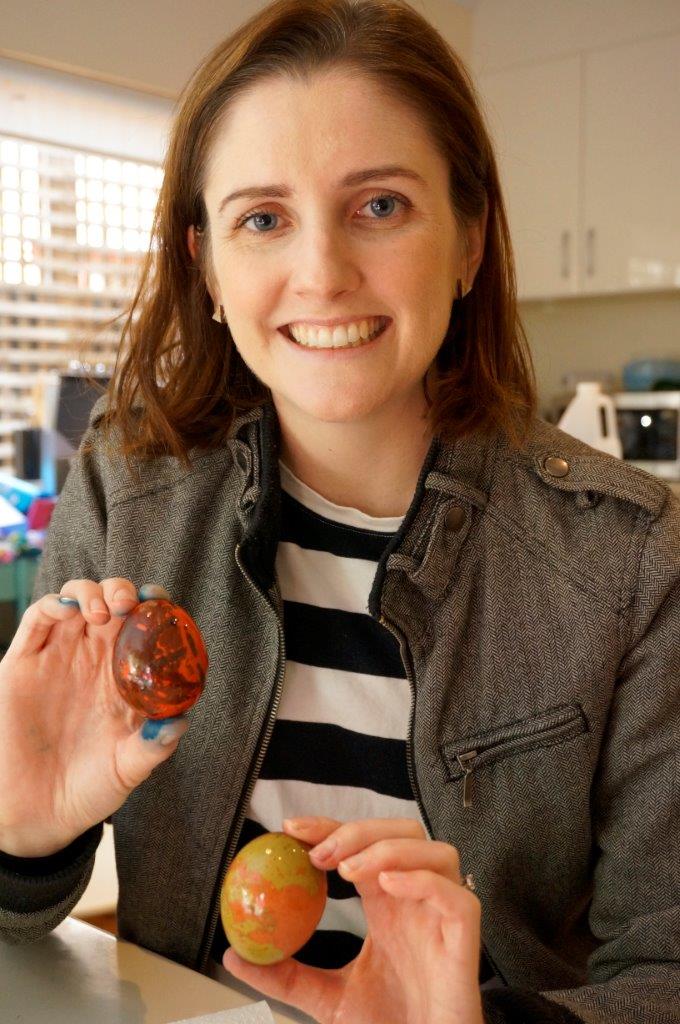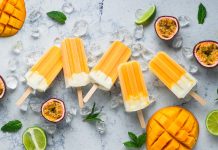Charlotte Barkla, author of Edie’s Experiments: How to Make Friends shares some egg-cellent ideas for science at home this Easter.
Incorporating science learning at home doesn’t have to be complicated. There are plenty of activities you can do with household objects, and some egg-cellent ones to try around Easter!
Here are three of Edie’s favourite eggs-periments:
Galaxy-Themed Easter Eggs
Equipment:
- Hard boiled eggs
- Oil
- Food colouring
- Vinegar
- Water
- Small plastic bowls, cups and spoons
Method:

- With an adult’s help, mix one cup of hot water with a few drops of food colouring and a teaspoon of vinegar.
- Repeat with as many colours as like! (Each cup should now contain a different coloured liquid.)
- Place one egg into each cup, and let it sit for a few minutes. (Make sure the whole egg is covered in liquid, so the entire egg shell can be dyed.)
- Remove the eggs from the liquid and place on paper towels to dry off.
- Add two to three centimetres of water to each bowl, along with one tablespoon of oil and five drops of food colouring.
- Place one egg into each bowl. (The liquid should only cover half the egg). Spoon the mixture over the egg and let it sit for a few minutes.
- Roll the egg over, to let the dye soak into the other side.
- Scoop the eggs out and place them onto paper towels to dry.
You should now have a set of galaxy-themed homemade Easter eggs!
Explanation: The oil in the second mixture prevents the food colouring from properly adhering to the egg shell, giving the shell its marbled appearance.
Rubber Eggs-periment
Equipment:
- Egg (a raw egg works best, but you can use a hard-boiled egg if you’d prefer less mess!)
- Vinegar
- Cup or glass
- Food colouring (optional)
Method:
- Carefully place the egg in the glass, and fill the glass with vinegar. (The egg needs to be completely covered with vinegar.)
- If you’d like to create a coloured egg, add 2-3 drops of food colouring to the mixture.
- Leave the egg in the vinegar for 48 hours, until the shell has completely dissolved.
- Remove the egg from the mixture. The shell should have completed dissolved, leaving only the egg membrane intact.
- Gently pat the egg dry, then test out your rubbery egg! With only the membrane intact, the egg will feel rubbery, and should bounce (a little) when dropped on your kitchen bench. Warning: if using a raw egg, the membrane will break if it’s bounced too hard!
Explanation:
The acetic acid in the vinegar dissolves the calcium carbonate of the shell. (This is an example of a reaction between an acid and a base.)
Dinosaur egg bath bombs activity
This is a variation of the bathbomb recipe from the Edie’s Experiments Activity Pack, with an egg-cellent twist!
Equipment:
- 1 cup baking soda
- ½ cup cornstarch
- ½ cup Epsom salts
- 4 tablespoons cream of tartar
- 2 tablespoons coconut oil (melted)
- 3 – 4 teaspoons water
- Food colouring
- Plastic Easter Egg moulds (or cupcake tray, if you don’t have one)
- Optional: Small plastic toys, such as dinosaurs.
Method:
- In one bowl, mix together the dry ingredients.
- In another bowl, mix together the wet ingredients.
- Whisk together all ingredients until the mixture forms a crumbly texture. It should be fairly dry but just wet enough to hold its shape when moulded together.
- Fill your mould with mixture, patting it down after adding each spoonful of mixture to make sure it’s tightly packed throughout the mould. (It has to be really tightly packed or it will fall apart when you remove it from the mould!) For a twist, add a small plastic toy such as a toy dinosaur to the centre of your bath bomb, when packing your mould.
- Leave them to dry.
- Gently squeeze the mould or tip it upside down to remove the bath bomb.
- Enjoy your fizzy ‘dinosaur egg’ bath bomb!
Further reading/activities:
Keen for some more science fun? Check out Edie’s Experiments: How to Make Friends, Edie’s new book for middle-grade readers. (You can even read an extract from the book here!)
And for more hands-on science at home, check out Edie’s Activities at Home, where new activities will be released every fortnight!
More stories like this:








